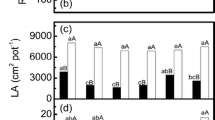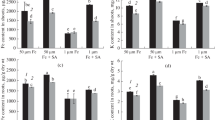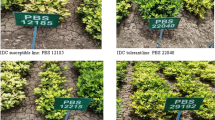Abstract
The growth of evergreen azaleas (Rhododendron spp.) can be altered by iron (Fe) chlorosis when plants are cultivated in a neutral-alkaline substrate. In this study, morphological and physiological responses to alkalinity and Fe deficiency were evaluated in five diploid Japanese azaleas to assess their potential as resources for breeding. R. obtusum ‘Kirin’, R. indicum ‘Shinsen’, R. × pulchrum ‘Sen-e-oomurasaki’, R. indicum ‘Osakazuki’, and R. ripense were pot cultivated in a peat-based substrate for 10 weeks, in acid and alkaline growing media with both adequate and inadequate Fe nutrition. Plant performance was generally affected by high pH of the substrate, while Fe deficiency by itself influenced few of the evaluated parameters, possibly due to the complex adaptive response mechanisms of these slow growing ornamental shrubs. According to the biochemical and physiological variations recorded on a long period of cultivation, R. indicum ‘Osakazuki’ reported the best performance. This azalea could be a valuable resource for breeders.




Similar content being viewed by others
Abbreviations
- GI:
-
Growth index
- IO:
-
R. indicum ‘Osakazuki’
- KR:
-
R. obtusum ‘Kirin’
- RI:
-
R. ripense
- SH:
-
R. indicum ‘Shinsen’
- SO:
-
R. × pulchrum ‘Sen-e-oomurasaki’
References
Abadía J, Vázquez S, Rellán-Álvarez R et al (2011) Towards a knowledge-based correction of iron chlorosis. Plant Physiol Biochem 49:471–482. doi:10.1016/j.plaphy.2011.01.026
Albano JP, Miller WB (1998) Marigold cultivars vary in susceptibility to iron toxicity. HortScience 33:1180–1182
Alcántara E, Romera FJ, de la Guardia MD (1988) Genotypic differences in bicarbonate-induced iron chlorosis in sunflower. J Plant Nutr 11:65–75. doi:10.1080/01904168809363785
Alcántara E, Romera FJ, Cañete M, De la Guardia MD (2000) Effects of bicarbonate and iron supply on Fe(III) reducing capacity of roots and leaf chlorosis of the susceptible peach rootstock “Nemaguard”. J Plant Nutr 23:1607–1617. doi:10.1080/01904160009382127
Alcántara E, Montilla I, Ramírez P et al (2012) Evaluation of quince clones for tolerance to iron chlorosis on calcareous soil under field conditions. Sci Hortic (Amsterdam) 138:50–54. doi:10.1016/j.scienta.2012.02.004
Arve LE, Terfa MT, Gislerød HR et al (2013) High relative air humidity and continuous light reduce stomata functionality by affecting the ABA regulation in rose leaves. Plant Cell Environ 36:382–392. doi:10.1111/j.1365-3040.2012.02580.x
Berruti A, Scariot V (2012) Coconut fiber: a peat-like substrate for acidophilic plant cultivation. In: Acta Horticulturae. pp 629–636
Bosco R, Caser M, Vanara F, Scariot V (2013) Development of a rapid LC-DAD/FLD method for the simultaneous determination of auxins and abscisic acid in plant extracts. J Agric Food Chem 61:10940–10947. doi:10.1021/jf4034305
Bosco R, Caser M, Ghione GG et al (2014) Dynamics of abscisic acid and indole-3-acetic acid during the early-middle stage of seed development in Rosa hybrida. Plant Growth Regul 75:265–270. doi:10.1007/s10725-014-9950-8
Briat JF, Lobréaux S (1997) Iron transport and storage in plants. Trends Plant Sci 2:187–193
Bunt AC (1973) Some physical and chemical characteristics of loamless pot-plant substrates and their relation to plant growth. In: I Symposium on Artificial Media in Horticulture 37. pp 1954–1965
Cakmak I (2005) The role of potassium in alleviating detrimental effects of abiotic stresses in plants. J Plant Nutr Soil Sci 168:521–530
Chaanin A, Preil W (1994) Influence of bicarbonate on iron deficiency chlorosis in Rhododendron. Acta Hortic 364:71–78
Clark MB, Mills HA, Robacker CD, Latimer JG (2003) Influence of nitrate:ammonium ratios on growth and elemental concentration in two azalea cultivars. J Plant Nutr 26:2503–2520. doi:10.1081/PLN-120025475
Cutler SR, Rodriguez PL, Finkelstein RR, Abrams SR (2010) Abscisic acid: emergence of a core signaling network. Annu Rev Plant Biol 61:651–679. doi:10.1146/annurev-arplant-042809-112122
De Schepper S, Leus L, Mertens M et al (2001) Flow cytometric analysis of ploidy in Rhododendron (subgenus Tsutsusi). HortScience 36:125–127
Demasi S, Caser M, Kobayashi N et al (2015a) Hydroponic screening for iron deficiency tolerance in evergreen azaleas. Not Bot Hortic Agrobot Cluj-Napoca 43:210–213. doi:10.15835/nbha4319929
Demasi S, Handa T, Scariot V (2015b) Ferric chelate reductase activity under iron deficiency stress in azalea. Int J Hortic Floric 3:157–160
Doležel J, Greilhuber J (2010) Nuclear genome size: are we getting closer? Cytom Part A 77:635–642
Dolezel J, Bartos J, Voglmayr H, Greilhuber J (2003) Nuclear DNA content and genome size of trout and human. Cytometry A 51:127–128. doi:10.1002/cyto.a.10013
Fisher PR, Wik RM, Smith BR et al (2003) Correcting iron deficiency in calibrachoa grown in a container medium at high pH. Hort Technol 13:308–313
Galle FC (1987) Azaleas (Revised and enlarged edition). Timber Press, Portland
Giel P, Bojarczuk K (2002) The effect of high concentration of selected calcium salts on development of microcuttings of rhododendron R. “Catawbiense Grandiflorum” in in vitro cultures. Dendrobiology 48:23–29
Giel P, Bojarczuk K (2011) Effects of high concentrations of calcium salts in the substrate and its pH on the growth of selected rhododendron cultivars. Acta Soc Bot Pol 80:105–114
Greer H (1984) The Satsuki Azaleas
Greilhuber J, Doležel J, Lysák MA, Bennett MD (2005) The origin, evolution and proposed stabilization of the terms “genome size” and “C-value” to describe nuclear DNA contents. Ann Bot. doi:10.1093/aob/mci019
Greilhuber J, Temsch EM, Loureiro J (2007) Nuclear DNA content measurement. Flow Cytom Plant Cells 67–101
Gupta UC (1968) Studies on the O-phenanthroline method for determining iron in plant materials. Plant Soil 28:298–305. doi:10.1007/BF01880247
Hansen NC, Hopkins BG, Ellsworth JW, Jolley VD (2006) Iron nutrition in field crops. In: Barton LL, Abadia J (eds) Iron Nutrition in plants and rhizospheric microorganisms. Springer, Dordrecht, pp 23–59
Hell R, Stephan UW (2003) Iron uptake, trafficking and homeostasis in plants. Planta 216:541–551. doi:10.1007/s00425-002-0920-4
Heursel J (1975) Inheritance of the flavonols azaleatin and quercetin in Rhododendron simsii Planch. and Rh. obtusum Planch. Z Pflanzenzüchtg 74:62–70
Hidalgo PR, Harkess RL (2002) Earthworm castings as a substrate amendment for chrysanthemum production. HortScience 37:1035–1039
Islam AKMS, Edwards DG, Asher CJ (1980) pH optima for crop growth—Results of a flowing solution culture experiment with six species. Plant Soil 54:339–357. doi:10.1007/BF02181830
Jelali N, Ben Salah I, M’sehli W et al (2011) Comparison of three pea cultivars (Pisum sativum) regarding their responses to direct and bicarbonate-induced iron deficiency. Sci Hortic (Amsterdam) 129:548–553. doi:10.1016/j.scienta.2011.06.010
Jolley VD, Cook KA, Hansen NC, Stevens WB (1996) Plant physiological responses for genotypic evaluation of iron efficiency in strategy I and strategy II plants—A review. J Plant Nutr 19:1241–1255
Jones JR, Ramsey TG, Lynch N, Krebs SDRS (2007) Ploidy levels and relative genome sizes of diverse species, hybrids, and cultivars of Rhododendron. J Am Rhododendron Soc Fall 61(4):220–227
Kaufman SR, Smouse PE (2001) Comparing indigenous and introduced populations of Melaleuca quinquenervia (Cav.) Blake: response of seedlings to water and pH levels. Oecologia 127:487–494. doi:10.1007/s004420000621
Kim SA, Guerinot ML (2007) Mining iron: iron uptake and transport in plants. FEBS Lett 581:2273–2280. doi:10.1016/j.febslet.2007.04.043
Kobayashi T, Nishizawa NK (2012) Iron uptake, translocation, and regulation in higher plants. Annu Rev Plant Biol 63:131–152. doi:10.1146/annurev-arplant-042811-105522
Kofranek AM, Lunt OR (1975) Mineral nutrition. In: Kofranek AM, Larson RA (eds) Growing azaleas commercially. division of agricultural sciences, University of California, pp 36–46
Lei GJ, Zhu XF, Wang ZW et al (2014) Abscisic acid alleviates iron deficiency by promoting root iron reutilization and transport from root to shoot in Arabidopsis. Plant Cell Environ 37:852–863. doi:10.1111/pce.12203
Lemaire F (1994) Physical, chemical and biological properties of growing medium. Hydroponics Transpl Prod 396:273–284
Lichtenthaler HK (1987) Chlorophylls and carotenoids: pigments of photosynthetic biomembranes. Methods Enzymol 148:350–382
Loeppert RH, Wei LC, Ocumpaugh WR (1994) Soil factors influencing the mobilization of iron in calcareous soils. In: Manthey JA, Crowley DA, Luster DG (eds) Biochemistry of metal micronutrients in the rhizosphere. Lewis, Boca Raton, pp 343–360
Lucena JJ (2000) Effects of bicarbonate, nitrate and other environmental factors on iron deficiency chlorosis. A review. J Plant Nutr 23:1591–1606. doi:10.1080/01904160009382126
Marschner H (1995) Mineral Nutrition of Higher Plants, 2nd edn. Academic Press, Cambridge
Marschner H, Römheld V, Kissel M (1986) Different strategies in higher plants in mobilization and uptake of iron. J Plant Nutr 9:695–713. doi:10.1080/01904168609363475
Martínez-Cuenca M-R, Forner-Giner MÁ, Iglesias DJ et al (2013) Strategy I responses to Fe-deficiency of two Citrus rootstocks differing in their tolerance to iron chlorosis. Sci Hortic (Amsterdam) 153:56–63. doi:10.1016/j.scienta.2013.01.009
Miller GW, Pushnik JC, Welkie GW (1984) Iron chlorosis, a world wide problem, the relation of chlorophyll biosynthesis to iron. J Plant Nutr 7:1–22. doi:10.1080/01904168409363172
Nelson EC (1999) So many really fine plants–an epitome of Japanese plants in Western European gardens. Curtis’s Bot Mag 16:52–68
Peleg Z, Blumwald E (2011) Hormone balance and abiotic stress tolerance in crop plants. Curr Opin Plant Biol 14:290–295. doi:10.1016/j.pbi.2011.02.001
Pestana M, David M, de Varennes A et al (2001) Responses of “Newhall” orange trees to iron deficiency in hydroponics: effects on leaf chlorophyll, photosynthetic efficiency, and root ferric chelate reductase activity. J Plant Nutr 24:1609–1620. doi:10.1081/PLN-100106024
Pfarr E, Hokanson S, McNamara S (2015) Evaluating high soil ph tolerance of rhododendron cultivars. University of Minnesota Digital Conservancy
Preil W, Ebbinghaus R (1994) Breeding lime-tolerant Rhododendron rootstocks. Acta Hortic 364:61–70
Raviv M, Wallach R, Blom TJ (2001) The effect of physical properties of soilless media on plant performance—A review. In: International Symposium on Growing Media and Hydroponics 644. pp 251–259
Riviere L-M, Caron J (1999) Research on substrates: state of the art and need for the coming 10 years. In: International Symposium on Growing Media and Hydroponics 548. pp 29–42
Römheld V (2000) The chlorosis paradox: Fe inactivation as a secondary event in chlorotic leaves of grapevine. J Plant Nutr 23:1629–1643. doi:10.1080/01904160009382129
Saywell LG, Cunningham BB (1937) Determination of iron: colorimetric o-phenanthroline method. Ind Eng Chem 9:67–69
Scariot V, Kobayashi N (2008) Evaluation of variability in Japanese wild azaleas and application of lime-tolerant genetic resources for breeding. B. Abstr. First Symp. Hortic. Eur. 268–269
Scariot V, Caser M, Kobayashi N (2013) Evergreen azaleas tolerant to neutral and basic soils: breeding potential of wild genetic resources. Acta Hortic 990:287–292
Schmidt W (1999) Mechanisms and regulation of reduction-based iron uptake in plants. New Phytol 141:1–26. doi:10.1046/j.1469-8137.1999.00331.x
Smith BR, Fisher PR, Argo WR (2004a) Water-soluble fertilizer concentration and pH of a peat-based substrate affect growth, nutrient uptake, and chlorosis of container-grown seed geraniums. J Plant Nutr 27:497–524. doi:10.1081/PLN-120028875
Smith BR, Fisher PR, Argo WR (2004b) Nutrient uptake in container-grown impatiens and petunia in response to root substrate pH and applied micronutrient concentration. HortScience 39:1426–1431
Stanton KM, Mickelbart MV (2014) Growth and foliar nutrition of Spiraea alba Du Roi and Spiraea tomentosa L. in response to root zone pH. Sci Hortic (Amsterdam) 165:23–28. doi:10.1016/j.scienta.2013.10.027
Symonds WL, Campbell LC, Clemens J (2001) Response of ornamental Eucalyptus from acidic and alkaline habitats to potting medium pH. Sci Hortic (Amsterdam) 88:121–131. doi:10.1016/S0304-4238(00)00202-8
Tagliavini M, Rombolà AD (2001) Iron deficiency and chlorosis in orchard and vineyard ecosystems. Eur J Agron 15:71–92. doi:10.1016/S1161-0301(01)00125-3
Thomashow MF (1999) Plant cold acclimation: freezing tolerance genes and regulatory mechanisms. Annu Rev Plant Biol 50:571–599
Thomine S, Lanquar V (2011) Iron transport and signaling in plants. In: Transporters and pumps in plant signaling. Springer, pp 99–131
Tod H (1959) Rhododendrons and lime. RHS Rhododendron Camellia Yearb 13:19–24
Valdez-Aguilar LA, Reed DW (2006) Comparison of growth and alkalinity-induced responses in two cultivars of hibiscus (Hibiscus rosa-sinensis L.). HortScience 41:1704–1708
Valdez-Aguilar LA, Reed DW (2007) Response of selected greenhouse ornamental plants to alkalinity in irrigation water. J Plant Nutr 30:441–452. doi:10.1080/01904160601171983
Van Laere K, Leus L, Van Huylenbroeck J, Van Bockstaele E (2009) Interspecific hybridisation and genome size analysis in Buddleja. Euphytica 166:445–456. doi:10.1007/s10681-008-9844-9
Vogler H, Kuhlemeier C (2003) Simple hormones but complex signalling. Curr Opin Plant Biol 6:51–56. doi:10.1016/S1369-5266(02)00013-4
Wallace A, Wallace GA (1986) Ornamental plants most likely to be killed by iron deficiency and some control measures. J Plant Nutr 9:1009–1014
Wendel JF (2000) Genome evolution in polyploids. Plant Mol Biol 42:225–249. doi:10.1023/A:1006392424384
Wilkinson S, Davies WJ (2002) ABA-based chemical signalling: the co-ordination of responses to stress in plants. Plant Cell Environ 25:195–210. doi:10.1046/j.0016-8025.2001.00824.x
Wulandari C, Muraki S, Hisamura A et al (2014) Effect of iron deficiency on root ferric chelate reductase, proton extrusion, biomass production and mineral absorption of citrus root stock Orange Jasmine (Murraya exotica L.). J Plant Nutr 37:50–64. doi:10.1080/01904167.2013.837178
Xiong L, Zhu JK (2003) Regulation of abscisic acid biosynthesis. Plant Physiol 133:29–36. doi:10.1104/pp.103.025395
Acknowledgements
The research was financially supported by the Italian ‘Ministero dell’Istruzione, dell’Università e della Ricerca’ (Project PRIN 2009, prot. 2009BW3KL4_003). The mobility of SD was funded by ForESTFlowers Project (FP7-PEOPLE-2010-IRSES-269204). The authors wish to thank Kazuki Koiwai, Tomoki Takaku and Walter Gaino for providing technical assistance.
Author information
Authors and Affiliations
Corresponding author
Ethics declarations
Conflict of interest
The authors declare that have no conflict of interest.
Additional information
This article is part of the Topical Collection on Plant Breeding: the Art of Bringing Science to Life. Highlights of the 20th EUCARPIA General Congress, Zurich, Switzerland, 29 August–1 September 2016
Edited by Roland Kölliker, Richard G. F. Visser, Achim Walter & Beat Boller
Rights and permissions
About this article
Cite this article
Demasi, S., Caser, M., Handa, T. et al. Adaptation to iron deficiency and high pH in evergreen azaleas (Rhododendron spp.): potential resources for breeding. Euphytica 213, 148 (2017). https://doi.org/10.1007/s10681-017-1931-3
Received:
Accepted:
Published:
DOI: https://doi.org/10.1007/s10681-017-1931-3




